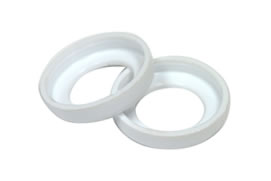
Washers come in a variety of styles. While nearly all of them consist of a ring-shaped piece of metal, some of them are slightly raised. Cupped washers, for instance, have a raised and canonical design. They aren’t completely flat like other washers. Rather, cupped washers are slightly raised.
#1) Also Known as Belleville Washers
Cupped washers are also known as Belleville washers. It’s a reference to their inventor, Julien Belleville. In 1867, Belleville filed a patent for cupped washers. Today, the term “Belleville washer” is synonymous with “cupped washer.” They both refer to raised and canonical washers.
#2) Provides an Axial Force
Like flat washers, cupped washers provide an axial force. An axial force is a pulling force. You can use cupped washers by placing them around a threaded fastener. As you drive the threaded fastener into an object, the cupped washer will deform. The cupped washer will essentially become sandwiches between the fastener’s head and the surface of the object, thus causing it to deform. And upon deformation, the cupped washer will provide an axial force.
#3) Available in Different Materials
Cupped washers are available in different materials. You can find them in alloys, such as carbon steel and stainless steel. You can also find cupped washers in nylon. Nylon, of course, is softer than most alloys. Nylon cupped washers are still able to provide an axial force, but they feature a softer construction than their alloy and metal counterparts.
#4) Used to Dampen Vibrations in Automobiles and Airplanes
Both automobiles and airplanes use cupped washers to dampen vibrations. The engines in automobiles and airplanes will produce vibrations. When threaded fasteners are exposed to these vibrations, they may loosen. Cupped washers, however, can dampen vibrations. As they provide an axial or “pulling” force, they’ll dampen vibrations so that the threaded fasteners with which they are used remain in place.
#5) Can Be Stacked
Cupped washers can be stacked. In other words, you don’t have to use a single cupped washer around any given threaded fastener. You can use two or more cupped washers together. Stacking cupped washers will allow you to change the spring constant, which is the amount of force needed to compress them. If you stack the cupped washers in the same direction, the spring constant will increase. If you stack the cupped washers in alternating and different directions, the spring constant will decrease.



